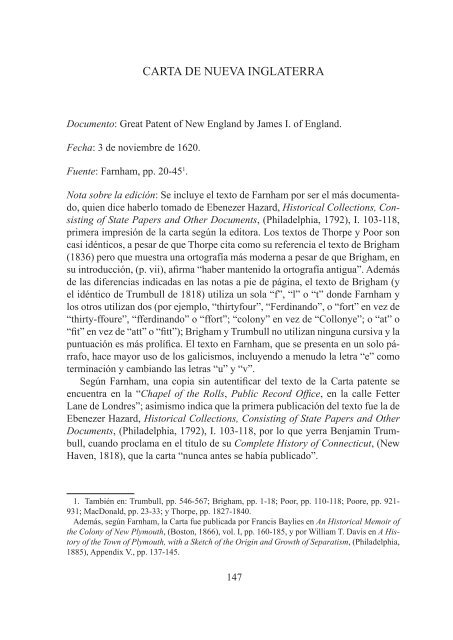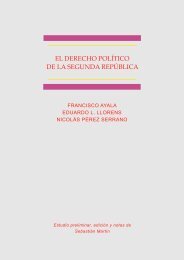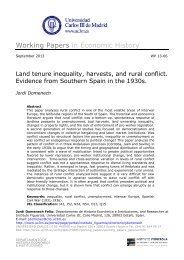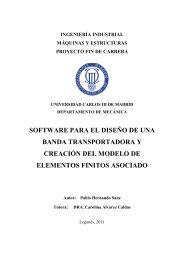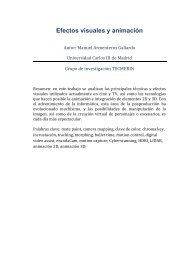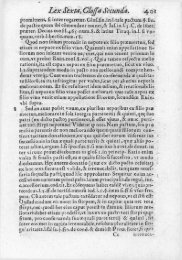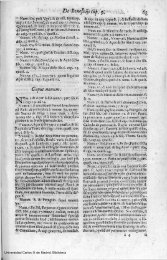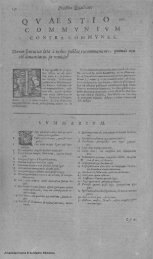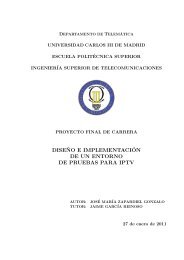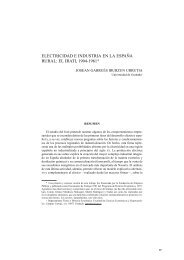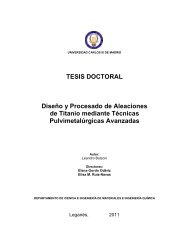- Page 3:
Selected Documents Illustrative of
- Page 6 and 7:
© Universidad Carlos III de Madrid
- Page 9 and 10:
ÍNDICE In t r o d u c c I ó n
- Page 11:
IntroduccIón
- Page 14 and 15:
INTRODUCCIÓN británico, fuente in
- Page 16 and 17:
INTRODUCCIÓN tectorado) los purita
- Page 18 and 19:
INTRODUCCIÓN ño condado que decla
- Page 20 and 21:
INTRODUCCIÓN La mayoría de los te
- Page 22 and 23:
INTRODUCCIÓN cíficas 14 . Otras c
- Page 24 and 25:
INTRODUCCIÓN veces no se indicaban
- Page 26 and 27:
INTRODUCCIÓN mento, es decir, la d
- Page 28 and 29:
INTRODUCCIÓN Puesto que el propós
- Page 30 and 31:
INTRODUCCIÓN término original Sig
- Page 32 and 33:
INTRODUCCIÓN va un gran número de
- Page 34 and 35:
Abreviaturas desarrollo Le’rs let
- Page 36 and 37:
BIBLIOGRAFÍA and Adoption of the F
- Page 38 and 39:
BIBLIOGRAFÍA Cooper, Thomas, The S
- Page 40 and 41:
BIBLIOGRAFÍA [Hutchinson, Thomas],
- Page 42 and 43:
BIBLIOGRAFÍA of Printing Records -
- Page 44 and 45:
BIBLIOGRAFÍA November, 1780, to Ma
- Page 47:
documentos
- Page 50 and 51:
LUIS GRAU ish Public Record Office,
- Page 52 and 53:
LUIS GRAU I. JAMES, by the Grace of
- Page 54 and 55:
LUIS GRAU IV. an d do therefore, fo
- Page 56 and 57:
LUIS GRAU Habitation, at any Place
- Page 58 and 59:
LUIS GRAU Councils; Each of which S
- Page 60 and 61:
LUIS GRAU give full Power and Autho
- Page 62 and 63:
LUIS GRAU shall so traffick, two an
- Page 64 and 65:
LUIS GRAU and born, within this our
- Page 66 and 67:
LUIS GRAU Hostility the said Offend
- Page 68 and 69:
LUIS GRAU Act, Ordinance, or Provis
- Page 71 and 72:
SEGUNDA CARTA DE VIRGINIA Documento
- Page 73 and 74:
Sello de la Compañía de Londres
- Page 75 and 76:
SEGUNDA CARTA DE VIRGINIA 1609 I. J
- Page 77 and 78:
SEGUNDA CARTA DE VIRGINIA 1609 Sali
- Page 79 and 80:
SEGUNDA CARTA DE VIRGINIA 1609 caba
- Page 81 and 82:
SEGUNDA CARTA DE VIRGINIA 1609 come
- Page 83 and 84:
SEGUNDA CARTA DE VIRGINIA 1609 Chri
- Page 85 and 86:
SEGUNDA CARTA DE VIRGINIA 1609 Isaa
- Page 87 and 88:
SEGUNDA CARTA DE VIRGINIA 1609 el g
- Page 89 and 90:
SEGUNDA CARTA DE VIRGINIA 1609 VI.
- Page 91 and 92:
SEGUNDA CARTA DE VIRGINIA 1609 la q
- Page 93 and 94:
SEGUNDA CARTA DE VIRGINIA 1609 Robe
- Page 95 and 96: SEGUNDA CARTA DE VIRGINIA 1609 de d
- Page 97 and 98: SEGUNDA CARTA DE VIRGINIA 1609 y ma
- Page 99 and 100: SEGUNDA CARTA DE VIRGINIA 1609 here
- Page 101 and 102: SEGUNDA CARTA DE VIRGINIA 1609 tene
- Page 103 and 104: SEGUNDA CARTA DE VIRGINIA 1609 here
- Page 105 and 106: SEGUNDA CARTA DE VIRGINIA 1609 XXVI
- Page 107: SEGUNDA CARTA DE VIRGINIA 1609 rega
- Page 110: LUIS GRAU Nota histórica: Como Sti
- Page 113 and 114: TERCERA CARTA DE VIRGINIA 1611-12 I
- Page 115 and 116: TERCERA CARTA DE VIRGINIA 1611-12 t
- Page 117 and 118: TERCERA CARTA DE VIRGINIA 1611-12 n
- Page 119 and 120: TERCERA CARTA DE VIRGINIA 1611-12 a
- Page 121 and 122: TERCERA CARTA DE VIRGINIA 1611-12 e
- Page 123 and 124: TERCERA CARTA DE VIRGINIA 1611-12 q
- Page 125 and 126: TERCERA CARTA DE VIRGINIA 1611-12 a
- Page 127 and 128: TERCERA CARTA DE VIRGINIA 1611-12 f
- Page 129 and 130: TERCERA CARTA DE VIRGINIA 1611-12 q
- Page 131 and 132: TERCERA CARTA DE VIRGINIA 1611-12 c
- Page 133: TERCERA CARTA DE VIRGINIA 1611-12 f
- Page 136 and 137: LUIS GRAU Nota histórica: Según P
- Page 138 and 139: LUIS GRAU TO THE KINGES MOST EXCELL
- Page 140 and 141: LUIS GRAU adventurers both knightes
- Page 143 and 144: AUTORIZACIóN DE CARTA PARA NUEVA I
- Page 145: AUTORIZACIÓN DE CARTA PARA NUEVA I
- Page 149 and 150: Nueva Inglaterra (aprox 1625)
- Page 151 and 152: CARTA DE NUEVA INGLATERRA 1620 Gran
- Page 153 and 154: CARTA DE NUEVA INGLATERRA 1620 caba
- Page 155 and 156: CARTA DE NUEVA INGLATERRA 1620 vari
- Page 157 and 158: CARTA DE NUEVA INGLATERRA 1620 inic
- Page 159 and 160: CARTA DE NUEVA INGLATERRA 1620 Earl
- Page 161 and 162: CARTA DE NUEVA INGLATERRA 1620 John
- Page 163 and 164: CARTA DE NUEVA INGLATERRA 1620 cuar
- Page 165 and 166: CARTA DE NUEVA INGLATERRA 1620 esta
- Page 167 and 168: CARTA DE NUEVA INGLATERRA 1620 dich
- Page 169 and 170: CARTA DE NUEVA INGLATERRA 1620 o pr
- Page 171 and 172: CARTA DE NUEVA INGLATERRA 1620 para
- Page 173 and 174: CARTA DE NUEVA INGLATERRA 1620 Y pa
- Page 175 and 176: CARTA DE NUEVA INGLATERRA 1620 sobr
- Page 177 and 178: CARTA DE NUEVA INGLATERRA 1620 y de
- Page 179 and 180: CARTA DE NUEVA INGLATERRA 1620 la m
- Page 181 and 182: CARTA DE NUEVA INGLATERRA 1620 de d
- Page 183 and 184: CARTA DE NUEVA INGLATERRA 1620 cada
- Page 185 and 186: CARTA DE NUEVA INGLATERRA 1620 robo
- Page 187 and 188: CARTA DE NUEVA INGLATERRA 1620 noso
- Page 189: CARTA DE NUEVA INGLATERRA 1620 Sien
- Page 192 and 193: LUIS GRAU Nota histórica: Según J
- Page 194 and 195: LUIS GRAU In y e9 name of God, Amen
- Page 196 and 197:
LUIS GRAU John Alden, Thomas Tinker
- Page 198 and 199:
LUIS GRAU rreligionarios puritanos
- Page 200 and 201:
LUIS GRAU the first PlyMouth Patent
- Page 202 and 203:
LUIS GRAU of shall yield together w
- Page 204 and 205:
LUIS GRAU acres so obteyned and pos
- Page 206 and 207:
LUIS GRAU & graunted / And shall al
- Page 208 and 209:
LUIS GRAU into a Register book for
- Page 211 and 212:
DECRETO DE VIRGINIA Documento: An O
- Page 214 and 215:
LUIS GRAU An Ordinance and Constitu
- Page 216 and 217:
LUIS GRAU Pountis, 9 Mr. Michael La
- Page 218 and 219:
LUIS GRAU England, and so ratified,
- Page 221 and 222:
CONCESIóN DE MAINE A GORGES Y MASO
- Page 224 and 225:
LUIS GRAU A Grant of the Province o
- Page 226 and 227:
LUIS GRAU fowling, comodities and h
- Page 228 and 229:
LUIS GRAU threescore miles be finis
- Page 230 and 231:
LUIS GRAU Islands rivers and premis
- Page 232 and 233:
LUIS GRAU appurtences to y e said S
- Page 234 and 235:
LUIS GRAU Gorges and Capt. John Mas
- Page 237 and 238:
CARTA DE LA BAHíA DE MASSACHUSETTS
- Page 239 and 240:
Sello de la Colonia de la Bahía de
- Page 241 and 242:
CARTA DE LA BAHÍA DE MASSACHUSETTS
- Page 243 and 244:
CARTA DE LA BAHÍA DE MASSACHUSETTS
- Page 245 and 246:
CARTA DE LA BAHÍA DE MASSACHUSETTS
- Page 247 and 248:
CARTA DE LA BAHÍA DE MASSACHUSETTS
- Page 249 and 250:
CARTA DE LA BAHÍA DE MASSACHUSETTS
- Page 251 and 252:
CARTA DE LA BAHÍA DE MASSACHUSETTS
- Page 253 and 254:
CARTA DE LA BAHÍA DE MASSACHUSETTS
- Page 255 and 256:
CARTA DE LA BAHÍA DE MASSACHUSETTS
- Page 257 and 258:
CARTA DE LA BAHÍA DE MASSACHUSETTS
- Page 259 and 260:
CARTA DE LA BAHÍA DE MASSACHUSETTS
- Page 261 and 262:
CARTA DE LA BAHÍA DE MASSACHUSETTS
- Page 263 and 264:
CARTA DE LA BAHÍA DE MASSACHUSETTS
- Page 265 and 266:
CARTA DE LA BAHÍA DE MASSACHUSETTS
- Page 267 and 268:
CARTA DE LA BAHÍA DE MASSACHUSETTS
- Page 269 and 270:
CARTA DE LA BAHÍA DE MASSACHUSETTS
- Page 271 and 272:
CARTA DE LA BAHÍA DE MASSACHUSETTS
- Page 273 and 274:
CARTA DE LA BAHÍA DE MASSACHUSETTS
- Page 275 and 276:
CARTA DE LA BAHÍA DE MASSACHUSETTS
- Page 277:
CARTA DE LA BAHÍA DE MASSACHUSETTS
- Page 280:
LUIS GRAU la ortografía, capitaliz
- Page 283 and 284:
LETRAS PATENTES DE SIR ROBERT HEATH
- Page 285 and 286:
LETRAS PATENTES DE SIR ROBERT HEATH
- Page 287 and 288:
LETRAS PATENTES DE SIR ROBERT HEATH
- Page 289 and 290:
LETRAS PATENTES DE SIR ROBERT HEATH
- Page 291 and 292:
LETRAS PATENTES DE SIR ROBERT HEATH
- Page 293 and 294:
LETRAS PATENTES DE SIR ROBERT HEATH
- Page 295 and 296:
LETRAS PATENTES DE SIR ROBERT HEATH
- Page 297 and 298:
LETRAS PATENTES DE SIR ROBERT HEATH
- Page 299 and 300:
LETRAS PATENTES DE SIR ROBERT HEATH
- Page 301:
LETRAS PATENTES DE SIR ROBERT HEATH
- Page 304 and 305:
LUIS GRAU The Charter of the Colony
- Page 306 and 307:
LUIS GRAU and p r cints sea waters
- Page 308 and 309:
LUIS GRAU towards the east, and bet
- Page 310 and 311:
LUIS GRAU hereditam ts and proffitt
- Page 312 and 313:
LUIS GRAU coaste 39 and sea shoares
- Page 314 and 315:
LUIS GRAU alsoe 50 powder shot ordn
- Page 316 and 317:
LUIS GRAU or 63 conveyances, assura
- Page 318 and 319:
LUIS GRAU the 76 thirteenth day of
- Page 321 and 322:
CONCESIóN DE RíO SACO A THOMAS LE
- Page 323 and 324:
CONCESIÓN DE RÍO SACO A THOMAS LE
- Page 325 and 326:
CONCESIÓN DE RÍO SACO A THOMAS LE
- Page 327 and 328:
CONCESIÓN DE RÍO SACO A THOMAS LE
- Page 329:
CONCESIÓN DE RÍO SACO A THOMAS LE
- Page 332 and 333:
LUIS GRAU hizo la transferencia a t
- Page 334 and 335:
LUIS GRAU The old patent of Connect
- Page 336 and 337:
LUIS GRAU said several rivers and e
- Page 339 and 340:
Documento: The Charter of Mary Land
- Page 341 and 342:
CARTA DE MARYLAND 1632 De concessio
- Page 343 and 344:
CARTA DE MARYLAND 1632 bus prefulge
- Page 345 and 346:
CARTA DE MARYLAND 1632 cendi ipsoru
- Page 347 and 348:
CARTA DE MARYLAND 1632 nostra hered
- Page 349 and 350:
CARTA DE MARYLAND 1632 nostris conv
- Page 351 and 352:
CARTA DE MARYLAND 1632 Carta de Mar
- Page 353 and 354:
CARTA DE MARYLAND 1632 y Watkins Po
- Page 355 and 356:
CARTA DE MARYLAND 1632 Para que los
- Page 357 and 358:
CARTA DE MARYLAND 1632 designar y e
- Page 359 and 360:
CARTA DE MARYLAND 1632 el derecho o
- Page 361 and 362:
CARTA DE MARYLAND 1632 como a todos
- Page 363 and 364:
CARTA DE MARYLAND 1632 someterse a
- Page 365 and 366:
CARTA DE MARYLAND 1632 Y además, p
- Page 367 and 368:
CARTA DE MARYLAND 1632 herederos y
- Page 369 and 370:
CARTA DE MARYLAND 1632 solariego 9
- Page 371 and 372:
CARTA DE MARYLAND 1632 los separamo
- Page 373 and 374:
CARTA DE MARYLAND 1632 unto the Pro
- Page 375 and 376:
CARTA DE MARYLAND 1632 whatsoever;
- Page 377 and 378:
CARTA DE MARYLAND 1632 tion with a
- Page 379 and 380:
CARTA DE MARYLAND 1632 not be burde
- Page 381 and 382:
CARTA DE MARYLAND 1632 of those Par
- Page 383 and 384:
ENCARGO REAL PARA REGULAR COLONIAS
- Page 386 and 387:
LUIS GRAU A copy of the commission
- Page 388 and 389:
LUIS GRAU by any of our people of E
- Page 390 and 391:
LUIS GRAU forms 15 of judicature, a
- Page 392 and 393:
LUIS GRAU wronging 25 another, or w
- Page 395 and 396:
DECLARACIóN DE RENUNCIA DE NUEVA I
- Page 397 and 398:
DECLARACIÓN DE RENUNCIA DE NUEVA I
- Page 399 and 400:
DECLARACIÓN DE RENUNCIA DE NUEVA I
- Page 401:
DECLARACIÓN DE RENUNCIA DE NUEVA I
- Page 404 and 405:
LUIS GRAU At a Meeting in the Earl
- Page 407 and 408:
RENUNCIA A LA CARTA DE NUEVA INGLAT
- Page 409 and 410:
DEVOLUCIÓN DE LA CARTA DE NUEVA IN
- Page 411:
DEVOLUCIÓN DE LA CARTA DE NUEVA IN
- Page 414 and 415:
LUIS GRAU COMMISSION TO SIR FERDINA
- Page 416 and 417:
LUIS GRAU making the first discover
- Page 419 and 420:
óRDENES FUNDAMENTALES DE CONNECTIC
- Page 421 and 422:
ÓRDENES FUNDAMENTALES DE CONNECTIC
- Page 423 and 424:
ÓRDENES FUNDAMENTALES DE CONNECTIC
- Page 425 and 426:
ÓRDENES FUNDAMENTALES DE CONNECTIC
- Page 427 and 428:
ÓRDENES FUNDAMENTALES DE CONNECTIC
- Page 429 and 430:
ÓRDENES FUNDAMENTALES DE CONNECTIC
- Page 431:
ÓRDENES FUNDAMENTALES DE CONNECTIC
- Page 434 and 435:
LUIS GRAU GRANT OF THE PROVINCE OF
- Page 436 and 437:
LUIS GRAU all the Islands and Ilett
- Page 438 and 439:
LUIS GRAU Chappells there as to the
- Page 440 and 441:
LUIS GRAU themselves 23 Waifes Estr
- Page 442 and 443:
LUIS GRAU and 30 Residents of or wi
- Page 444 and 445:
LUIS GRAU Deputie of the said Provi
- Page 446 and 447:
LUIS GRAU and 42 Premisses under th
- Page 448 and 449:
LUIS GRAU lawefull to and for the s
- Page 450 and 451:
LUIS GRAU landeing bringeing in and
- Page 452 and 453:
LUIS GRAU a 55 Shoare of the said P
- Page 454 and 455:
LUIS GRAU Sir Fardinando Gorges his
- Page 456 and 457:
LUIS GRAU and authorities whatsoeve
- Page 458 and 459:
LUIS GRAU and other Vessells as sha
- Page 460 and 461:
LUIS GRAU thither or returning from
- Page 462 and 463:
LUIS GRAU bee forever hereafter est
- Page 464 and 465:
LUIS GRAU Vice-admiralls Generalls
- Page 466 and 467:
LUIS GRAU whereuppon the same or an
- Page 469 and 470:
ARTíCULOS FUNDAMENTALES DE NUEVA H
- Page 471 and 472:
ARTÍCULOS FUNDAMENTALES DE NUEVA H
- Page 473 and 474:
ARTÍCULOS FUNDAMENTALES DE NUEVA H
- Page 475 and 476:
ARTÍCULOS FUNDAMENTALES DE NUEVA H
- Page 477 and 478:
ARTÍCULOS FUNDAMENTALES DE NUEVA H
- Page 479 and 480:
ARTÍCULOS FUNDAMENTALES DE NUEVA H
- Page 481:
ARTÍCULOS FUNDAMENTALES DE NUEVA H
- Page 484 and 485:
LUIS GRAU EXETER COMBINATION, 1639.
- Page 486 and 487:
Mon., 5th d., 4th, 1639. 10 LUIS GR
- Page 488 and 489:
LUIS GRAU Report of Arbitrators at
- Page 490 and 491:
LUIS GRAU you can apprehend, and to
- Page 492 and 493:
LUIS GRAU if any person giue notice
- Page 494 and 495:
LUIS GRAU These being those things
- Page 497 and 498:
ASOCIACIóN DE LOS HABITANTES DE PI
- Page 499 and 500:
Primer sello de la Colonia de Nueva
- Page 501:
ASOCIACIÓN DE LOS HABITANTES DE PI
- Page 504 and 505:
LUIS GRAU Wi l l i a M br a d f o r
- Page 506 and 507:
LUIS GRAU of Naemskeckett and from
- Page 508 and 509:
LUIS GRAU Memorand. That the said s
- Page 511 and 512:
CUERPO DE LIBERTADES DE MASSACHUSET
- Page 513 and 514:
CUERPO DE LIBERTADES DE MASSACHUSET
- Page 515 and 516:
CUERPO DE LIBERTADES DE MASSACHUSET
- Page 517 and 518:
CUERPO DE LIBERTADES DE MASSACHUSET
- Page 519 and 520:
CUERPO DE LIBERTADES DE MASSACHUSET
- Page 521 and 522:
CUERPO DE LIBERTADES DE MASSACHUSET
- Page 523 and 524:
CUERPO DE LIBERTADES DE MASSACHUSET
- Page 525 and 526:
CUERPO DE LIBERTADES DE MASSACHUSET
- Page 527 and 528:
CUERPO DE LIBERTADES DE MASSACHUSET
- Page 529 and 530:
CUERPO DE LIBERTADES DE MASSACHUSET
- Page 531 and 532:
CUERPO DE LIBERTADES DE MASSACHUSET
- Page 533 and 534:
CUERPO DE LIBERTADES DE MASSACHUSET
- Page 535 and 536:
CUERPO DE LIBERTADES DE MASSACHUSET
- Page 537 and 538:
CUERPO DE LIBERTADES DE MASSACHUSET
- Page 539 and 540:
CUERPO DE LIBERTADES DE MASSACHUSET
- Page 541 and 542:
CUERPO DE LIBERTADES DE MASSACHUSET
- Page 543:
CUERPO DE LIBERTADES DE MASSACHUSET
- Page 546 and 547:
LUIS GRAU The Generall Court of Ele
- Page 548 and 549:
LUIS GRAU the said Treasurer; and t
- Page 550 and 551:
LUIS GRAU 13. It is ordered, that n
- Page 553 and 554:
ARTíCULOS DE CONFEDERACIóN DE NUE
- Page 555 and 556:
ARTÍCULOS DE CONFEDERACIÓN DE NUE
- Page 557 and 558:
ARTÍCULOS DE CONFEDERACIÓN DE NUE
- Page 559 and 560:
ARTÍCULOS DE CONFEDERACIÓN DE NUE
- Page 561 and 562:
ARTÍCULOS DE CONFEDERACIÓN DE NUE
- Page 563 and 564:
ARTÍCULOS DE CONFEDERACIÓN DE NUE
- Page 565 and 566:
ARTÍCULOS DE CONFEDERACIÓN DE NUE
- Page 567:
ARTÍCULOS DE CONFEDERACIÓN DE NUE
- Page 570 and 571:
Present. 3 Magistrates. Theophilus
- Page 572 and 573:
LUIS GRAU touching such offences, d
- Page 574 and 575:
LUIS GRAU on any busines as a Court
- Page 576 and 577:
LUIS GRAU Deputy Governo r , shall
- Page 578 and 579:
LUIS GRAU These gen rlls being thus
- Page 581 and 582:
PATENTE DE PROVIDENCIA Documento: P
- Page 583 and 584:
PATENTE DE PROVIDENCIA 1643 Patente
- Page 585 and 586:
PATENTE DE PROVIDENCIA 1643 han int
- Page 587:
PATENTE DE PROVIDENCIA 1643 como el
- Page 590 and 591:
LUIS GRAU Acts of Assembly of the 2
- Page 592 and 593:
LUIS GRAU Governor of this Province
- Page 594 and 595:
LUIS GRAU or cheife Officer or Offi
- Page 596 and 597:
LUIS GRAU against the civill Govern
- Page 599 and 600:
PETICIóN DE CARTA PARA CONNECTICUT
- Page 601 and 602:
PETICIÓN DE CARTA PARA CONNECTICUT
- Page 603:
PETICIÓN DE CARTA PARA CONNECTICUT
- Page 606 and 607:
LUIS GRAU CHARTER OF CONNECTICUT -
- Page 608 and 609:
LUIS GRAU in New England in America
- Page 610 and 611:
LUIS GRAU to Consult and advise of
- Page 612 and 613:
LUIS GRAU such greater part of them
- Page 614 and 615:
LUIS GRAU by vertue of theis presen
- Page 616 and 617:
LUIS GRAU Colony of Conecticutt, vn
- Page 618 and 619:
LUIS GRAU Natives of the Country to
- Page 620 and 621:
LUIS GRAU the said Governor and Com
- Page 622 and 623:
LUIS GRAU Narrogancett Bay on the E
- Page 625 and 626:
Documento: Charter of Carolina. Fec
- Page 627 and 628:
CARTA DE CAROLINA 1663 Carta de Car
- Page 629 and 630:
CARTA DE CAROLINA 1663 latitud sept
- Page 631 and 632:
CARTA DE CAROLINA 1663 nuestro domi
- Page 633 and 634:
CARTA DE CAROLINA 1663 Lord Ashley;
- Page 635 and 636:
CARTA DE CAROLINA 1663 6º. Y dado
- Page 637 and 638:
CARTA DE CAROLINA 1663 dominios; y
- Page 639 and 640:
CARTA DE CAROLINA 1663 para importa
- Page 641 and 642:
CARTA DE CAROLINA 1663 10º. Y adem
- Page 643 and 644:
CARTA DE CAROLINA 1663 George, duqu
- Page 645 and 646:
CARTA DE CAROLINA 1663 13º. Y para
- Page 647 and 648:
CARTA DE CAROLINA 1663 sus regiones
- Page 649 and 650:
CARTA DE CAROLINA 1663 capitán gen
- Page 651 and 652:
CARTA DE CAROLINA 1663 en cualquier
- Page 653:
CARTA DE CAROLINA 1663 tribunales,


